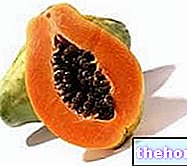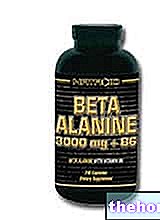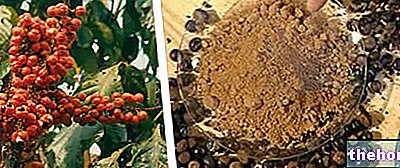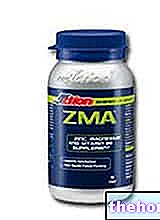See also: castor oil for eyelashes and hair
Castor oil is obtained by cold pressing the seeds of Ricinus communis, an arborescent plant belonging to the Euphorbiacee family. The lipid content of the seeds is heavily influenced by environmental conditions and is normally between 30 and 50%. The protein content is also decent (15-20%).

Castor seeds also contain a toxic substance - a glycoprotein lecithin called ricin - which can cause vomiting, haematemesis, gastrointestinal bleeding, convulsions and arrhythmias, up to coma and death. Ingestion of a few castor seeds (5-10) can be lethal.
The presence of ricin and another toxin, the alkaloid ricinin, severely limits the use of the panel in the zootechnical field. For this reason the efforts of agronomists and bioengineers are concentrating on the selection of species with a low content of toxins.
The castor has an erect, purplish-red stem, which enriches the landscapes of temperate and tropical areas, including Italy. The tree is grown - especially in India, China and Brazil - for the vast industrial use of castor oil, whose applications range from the pharmaceutical field (a constituent, called undecylenic acid, is known and used for its antifungal properties) to that of cosmetics, paints, plastic polymers and lubricants. However, one of the best known properties of castor oil remains its laxative. Its irritating action, which on an empty stomach takes place within 30-120 minutes of ingestion (interval necessary for pancreatic lipases to digest triglycerides into monoglycerides and ricinoleic acid) produces a purgative effect within 6-12 hours, with the emission of profuse discharges of semiliquid feces. Ricinoleic acid acts by stimulating the water secretion of the small intestine, thus accelerating peristalsis. Since the "increased intestinal transit causes the" elimination of triglycerides not yet hydrolyzed (digested), the laxative effect of castor oil is self-limiting. For this purpose, therapeutic doses range from 15 to 50 ml in adults and from 5 to 10 ml in children over two years of age ; in both cases it must be taken on an empty stomach. Absolutely forbidden to use it during pregnancy, since castor oil can cause violent uterine contractions.
Select plant Fir Acacia Acerola Sorrel Yarrow Yarrow Yarrow Aconito Adatoda Garlic Agnocasto Agrimonia Alchemilla Alkekengi Aloe Altea Witch Hazel Ammi or Visnaga Pineapple Andrographis Anemone Pulsatilla Angelica Anise Star Anise Japanese Star Anise Bitter Orange Bitter Areca Arnica Harpagophytum Arpagophyte Artemisia Asteragus Basil Asparagus Asparagus Peruvian Asparagus Asparagus Asparagus Hawthorn Boldo Borage Shepherd's Purse Boswellia Bucco Butea superba Cocoa Coffee Cajeput Calamus Calamus Marigold Camedrio Chamomile Roman Chamomile Camphor Cinnamon Ceylon Maidenhair Capuchin Artichoke Cardamom Cardiac Thistle Asian Thistle Carvi Cascara Cassia Catecu Catha Cabbage Celandine Chicory Centaurea Cinnamon Cypress Celandine Chives Cypress Coca Cola Colchico Combreto Condurango Comfrey Coriander Cranberry Barberry American Chrysanthemum Cumin Turmeric Damiana Digital Dioscorea Drosera Dulcamara Dunalilella Echinacea Eder a Ephedra Elenio Eleutherococcus Helichrysum Evening primrose Horsetail Alfalfa Erica Euphrasia Erisimo Escolzia Eucalyptus Farfara Farfaraccio Calabar bean Fenugreek Fennel Phytolacca Frangola Ash Fumaria Japanese Mushrooms Galega Ganoderma lucidum Garcinia Cambogia Mulberry Gentian Broom Ginkgo Ginkgo Guipana Guipana Gynestra Ginkgo Hibelia Gymnasium Hibiscus Guarulp St. John's Wort Horse Chestnut Ispaghul Hyssop Jaborandi Kava kava Konjac Laminaria Cherry Laurel Lavender Lemongrass Lespedeza Lovage Icelandic Lichen Lemon Flax Lippia Licorice Lobelia Hops Maca Marjoram Maize Mallow Manna Marrubio Marrubio d "water Matè Melaleuca Meliloto American Lemon balm Myrtle Myrama Walnut Nutmeg Walnut vomica Olive tree Meadowsweet Ononide Opuntia Oregano Orthosiphon Nettle Poppy Papaya Parietaria Feverfew Passiflora Chilli Perilla Periwinkle Phyllanthus Plantain Picrorhiza Pilosella Pino Pisci dia Podofillo Polygala Grapefruit Parsley Psyllium Pueraria mirifica Butcher's broom Pygeum Quassia Oak Rhubarb Ratania Rauwolfia currant Castor bean Rhodiola Rosehip Rosemary Rue Willow Sarsaparilla Sage Elderberry Sassafras Sedum Ergot Senna Serenoa Repens Soybean Solidago Tansy Taraxus Tamarind Tamarind Tamarind Tamarind Tamarindo Ursina Valerian Vanilla Mullein Verbena Veronica Viburnum Vinca Pansy Mistletoe Vine Withania Yohimbe Saffron Ginger Pumpkin Select disease Juvenile Acne Rosacea Tinnitus Tinnitus Aerophagia Tendon Affections Afonia Aphthae Algias Functional Halitosis Breastfeeding Allergy Anemia Anguish Anxiety Arteriosclerosis Asthrosis Asthrosis Arthritis Arthritis Men Sex Woman Blepharitis and Conjunctivitis Eye bags Bronchitis Gallstones Kidney stones Salivary stones Baldness Androgenetic Candida Fragile hair Caries Headache Cellulitis Motion sickness Cystitis C limaterio Cholecystopathy High cholesterol Ulcerative colitis Colonoscopy Bruises Hematoma Convalescence Couperose Depression Dermatitis Diaper rash Diabetes Diarrhea DysfunctionErectile Dyslipidemia Dysmenorrhea Dyspepsia Disturbance of vision Hemorrhoids Epistaxis Erethism Cardiac Fever Fibromyalgia Flatulence Phlebitis Gastritis Chilblains Gingivitis Herpes Loss of appetite Urinary infections Influenza Insomnia Hypersomnia Irritable bowel Hypertension Prostatic disease Hypertrophy Prostatic disease Renal laryngitis Disease of teeth Renal laryngitis Malheimer Crohn Nausea Vomiting Obesity Dark circles Onychomycosis Osteoporosis Dry skin Periarthritis Piorea Low blood pressure Prostatitis Psoriasis Cold Breast fissures Anal fissures Gastroesophageal reflux Nasopharyngitis Rolls (abdominal fat) Wrinkles Salmonella Senescence Premenstrual syndrome Sinusitis Stopping smoking Upsilis steatosis Steatosis Steatosis Fragile Hot Flashes Warts Dizziness Herbal Properties Abortive Tanning Adaptogens Aphrodisiacs Bitters Analgesics Anesthetics Anorexia zzanti analgesic antacid anti-allergic anti-asthmatic Antibiotic catarrh Anticellulitiche anticonvulsant Antidiaforetiche antidiarrheal edematous anthelmintic antiemetic Antiemorroidarie antiphlogistic Antiidrotiche Antinevrotiche Antioxidants antipyretic antirheumatic antiscorbutic Antiseptic antispasmodic anti-uric Aperitive Flavoring Astringent Balsamic Bechiche Capillarotrope cardiotonic Carminative Cathartic caustics Cicatrizant cholagogue choleretic Dyes Decongestants Deodorants purifying Detergents diaphoretic Disinfectants Detox Refreshing Diuretic Exciting emetic Emmenagoghe Emollients Hemostatic Energy Hepatoprotective Expectorants Eupeptic Photosensitizers Galactophores Galactofuges Galactogogues Moisturizing Immunostimulants Hypertensive Hypnotic Hypoglycemic Hypotensive Irritant Laxative Soothing Narcotic Nerves Nourishing Refreshing Odontalgating Rubefacenti Scialagoghe Sedative Soporifera Sneezing Stomachic Stomatics Narcotic Tenifuges Tonic Vasoconstrictors Vasodilators Vermifuges Vescicators Vitamins Vulneraries
















.jpg)











